Recalling the grocery stores of Albany's past
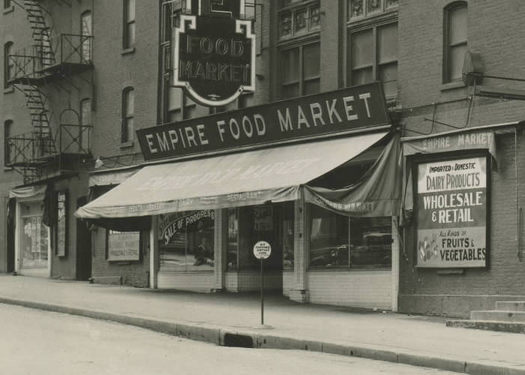
The Empire Food Market -- "Albany's Premier Food Center" -- in the old Lyon Block building in downtown Albany. (The building was knocked down during the Empire State Plaza construction.) / via the Albany Public Library History Collection
The trick of time is that it passes slowly, and changes are incremental, so you can hardly notice it happening. The world of today looks mostly like the world of yesterday to us, and yet there have been a thousand little changes over the years that separate those worlds. When things change all at once, it seems a revolution, but when they change little by little, it just seems the passing of time.
Grocery stores are one example. Sure, 50 years ago, they were selling milk and meats, frozen foods and Cap'n Crunch, just as they are today. And yet everything about them has changed.
The location of the stores changed
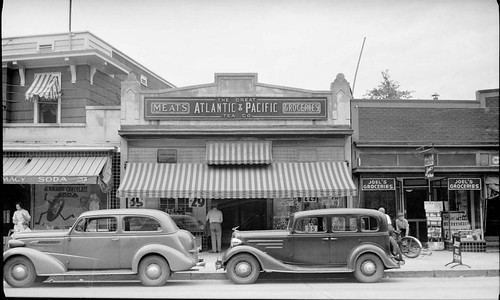
You might recognize this building on New Scotland Ave near Ontario -- it's now Restaurant Navona. / via Albany Group Archive, which has many local historical photos of old markets and shopping sites
Grocery stores in the Capital District used to be numerous, to say the least. The 1870 directory for Albany alone listed 17 wholesale grocers. Retail grocers counted in the hundreds, at a time when Albany's population was just about 70,000. In 1920, when Albany had 113,000 residents, there were 20 wholesalers and an even greater number of retailers, in every corner of the city.
Every neighborhood had several groceries in those days, and shopping for food was often a daily enterprise. The vast majority of these were small storefronts, usually the lower levels of residential buildings - you can often see reminders of them today, in places that long survived as neighborhood stores, as odd bump-outs on the fronts of brownstones, as enlarged entries and windows at the basement level.
Even when I was growing up in an older suburb in the '60s and '70s, they were still numerous. My first real job was working in one of them, one of the last of the high-quality butcher shops in the region, which was also a neighborhood grocery store.
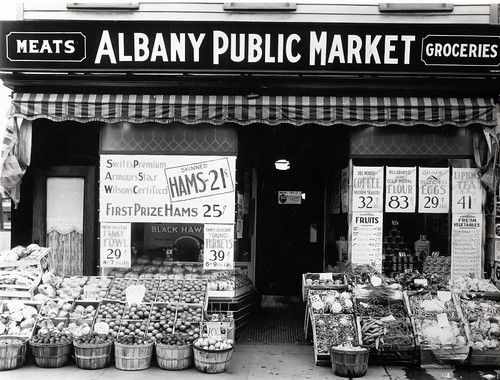
The former Albany Public Market location on Central Ave in the 1930s. / via Albany Group Archive
Somewhere around the 1930s the supermarket concept was developed - a neighborhood store, but with more, and run by a central chain. There were A&P stores, and Grand Unions and Mohicans. For a while, there was a chain associated with the area's seminal radio station, WGY Food Stores. But even as late as 1958, the chains barely had a hold. There was one A&P in Albany, one Albany Public Market, one Grand Union, four Empires, two Central Markets (later to become Price Chopper). Trading Post was the biggest chain in the city, with 5 locations.
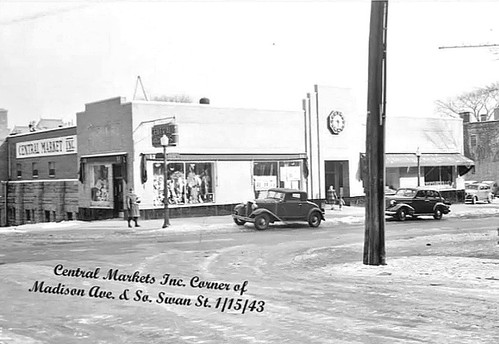
The former Central Market at Madison and South Swan in Albany. / via Albany Group Archive
The rest of the city's shopping was done at small neighborhood stores with names like Gimondo, Rosenberg, and Tanski. Even the so-called supermarkets were very much part of their neighborhoods in those days, often repurposing previous buildings -- such as the Central Markets location on Madison and Swan, which was built on the rather generous stone foundation of the Madison Avenue Second Reformed Church that had burned in 1930.
But with the move of population to the suburbs, the chains started to grow. Competition and demographics, and the willingness of Americans to drive absolutely everywhere rather than walk anywhere, contributed to bigger and bigger centrally-located, chain-owned stores, and the death of these tiny independents.
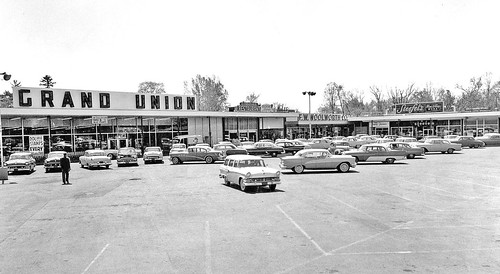
The shopping plaza on Delaware Ave in Bethlehem in the late 1950s or early 1960s. / via Albany Group Archive
And the experience of shopping in them changed, too
The stores themselves aren't the only thing about groceries that have changed. Almost everything else has, too, but in ways that are almost invisible. Everyone probably realizes that plastic grocery bags didn't even used to exist, and that soda and milk came exclusively in glass bottles, and was all bottled nearby. Burlap has practically disappeared from anything but craft stores, but 40 years ago, potatoes, onions and oranges all came in burlap sacks. Meat was nearly always cut to order, and wrapped in brown butcher paper, tied with string, rather than laid out on a foam tray and stacked in coolers. Even something as simple as a box of cereal isn't the same as it was four decades ago. The box itself is infinitely thinner for both environmental and economic reasons. The bag that actually holds the cereal used to be a satisfyingly thick, crinkly wax paper that would sort of stay closed; now it's a thin plastic film that never will. Very little food came in any kind of plastic container at all.
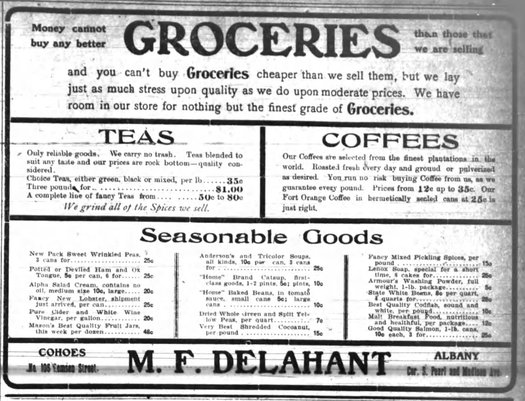
A 1903 ad for Delahant Groceries. (You can click on it for a larger view.)
Prices were not on little paper stickers (if those still exist) or posted on the shelves - they were stamped onto the ends of cans and boxes with heavy blue ink using a price stamper - the stockboy (that's what we were) would spin the numbers on the stamper to the correct price, press it against the ink pad, and then punch the stamper against the top of the can or box. (This is now so archaic that it's hard to even Google search for it.) When the prices needed to be changed (and in the days of inflation in the 1970s, that was often), the stockboy would clean the price off the can with a rag and nail polish remover so the new (higher) price could be stamped on.
(In the store I worked in, by the way, the markup from wholesale was 40%, much higher than the chains. That might seem outrageous, but that was money that paid local workers, sponsored the store's Little League team, and built wealth in the community, rather than sending it off to a corporate headquarters in a remote land.)
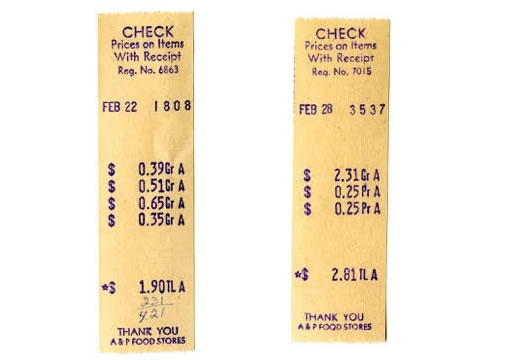
When you carried your groceries up to the register, there were no scanners. The check-out clerk had to enter each item's price into the cash register. Unmarked items weren't usually a problem - the clerk knew the price of most things. Your receipt had prices but only categories that would describe the items, such as "Gr" for grocery, "Pr" for produce, etc.
The most subtle change in grocery stores, as in most stores, is the ambient music. Whereas now you can expect the odd experience of hearing The Clash sing "Lost in the Supermarket" while you are, in fact, lost in the supermarket, real music in retail spaces didn't happen until the 1980s. For decades before that, there was something called Muzak, and its ilk: light, syrupy string arrangements of almost-identifiable melodies intended to give no offense and to set no pulse to racing. As a customer, it was just there. As an employee, it could make you insane. In the days before the Walkman was invented, I learned to play entire albums in my own head, note for note, so as to drown out the cloying melodies of the Muzak.
Today, the Albany area is, depending on how you count, down to three or four grocery chains with multiple locations (not counting Walmart or Target). Only one of them, Price Chopper, is local. Very few of them are within any of the city limits, catering almost entirely to the suburbanites.
But with the trend toward more and more downtown living, some form of the neighborhood store will have to re-emerge. Personally, I just hope it brings back burlap.
Carl Johnson writes about local history and life at Hoxsie! and My Non-Urban Life.
Hi there. Comments have been closed for this item. Still have something to say? Contact us.

Comments
I remember coming home from the store with a brown paper bag. The bread was wrapped in cellophane and was always on top of the other groceries. You could smell the beautiful scent of fresh baked bread all the way home.
... said Marie George on Nov 14, 2016 at 9:35 PM | link
Excellent article, Carl! You note that the Albany area is "down to three or four grocery chains," not counting Walmart or Target, but Walmart now accounts for about 25% of all grocery sales in the U.S., I'm sure that has a tremendous impact on our supermarkets.
... said Ellen on Nov 15, 2016 at 9:23 AM | link
I'll never forget going to our neighborhood A&P with my Dad, the store filled with the aroma of Eight O'Clock coffee beans in the grinders at the end of the small check-out aisles.
Those stores are gone, but not the memories.
... said Bob on Nov 15, 2016 at 10:16 AM | link
As a senior in high school (1962-63), I delivered groceries on Saturdays for a small Mom and Pop grocery store, Dom's Market, on Northern Boulevard in Albany. The owners were also friends of our family. In fact, my father had also delivered groceries for them more than 20 years earlier. If a customer's order requested an item that the store didn't stock, we went to a competing store and purchased it for them.
... said Roger K on Nov 15, 2016 at 7:39 PM | link
Great article! It's unfortunate that these small neighborhood grocery stores are not around anymore. Now there are so many corner stores with no fresh food within walking distance.
... said Thom on Nov 16, 2016 at 9:45 AM | link
When I was young we shopped at Carnevales, Star Market and the Trading Port. Carnevales was located approximately across the street from where the new Honest Weight Co-op is now.
... said Nancy Wagner on Nov 19, 2016 at 4:56 PM | link
Comment/Correction: Trading PORT - not Post - was owned by the Tabachneck Family from the 1940s up through at least the 1970s.
... said Ginny McCann on Oct 31, 2017 at 8:32 AM | link